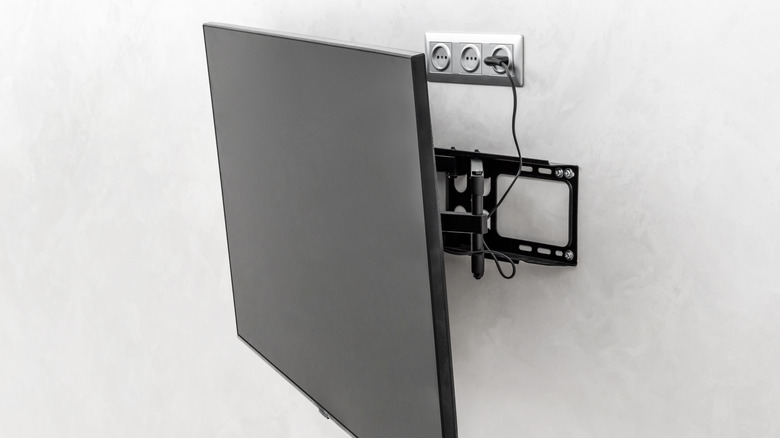What Size TV Mount Do You Need? Here's How To Find Out
Before you start drilling holes or shopping for brackets to mount your TV on the wall, there's one question that needs to be answered first: What size TV mount do you even need? It's about a lot more than just your screen size: It also involves TV compatibility, weight limits, and your viewing distance. For starters, you'll have to figure out the most important measurement: your TV's VESA pattern.
VESA, short for Video Electronics Standards Association, refers to the standardized spacing of the four mounting holes on the back of your TV. These measurements are always listed as "horizontal distance x vertical distance" and are always done in millimeters. (For example, a 400x200 VESA pattern means the horizontal holes are 400mm apart and the vertical holes are 200mm apart.) This information can usually be found in your TV's user manual, but you can measure the distance yourself with a ruler or tape measure.
Naturally, different VESA sizes correspond to different screen sizes: 200x200 is typical for TVs up to 32 inches, 400x400 for TVs up to 60 inches, and 600x400 for screens larger than that. Of course, TVs of the same size can have different VESA patterns. Likewise, two mounts rated for 55-inch TVs might not support the same VESA configurations. Always make sure to check both the size and the VESA standard when choosing a mount.
Match your TV mount type to your viewing style
Sometimes, it's not enough to just choose the right size. You'll also need to choose the right type of mount. Where are you placing the TV? How high will it be mounted? What are your preferred viewing angles? The answers to each of these questions come with a different type of TV mount.
Fixed mounts are low-profile and flush with the wall. Tilting mounts let you angle the screen downward for TVs mounted above eye level (like above a fireplace). Both of these types should be reserved for rooms where you can sit directly in front of the screen.
Full-motion mounts (also called articulating mounts) offer more flexibility than fixed or tilting mounts. They can tilt, swivel, extend, and retract, giving you a really wide range of viewing positions. Similarly, pull-down mounts can be lowered to eye level when in use and tucked back up when not. These mounts are best for corner installations or large rooms with multiple seating areas. Keep in mind: They may also be more complicated to install, especially for heavier TV sets.
Keep in mind your wall type and installation needs
As you know, not all walls are created equal. Your place might have drywall over wood studs, or you could be working with brick, concrete, or stone... Not to mention those of us with crumbly plaster walls in older homes and apartments. Drywall is probably the most common of the bunch, and it also tends to be the easiest for mounting. When doing so, it is so enormously important to locate the studs and secure the TV mount to them using lag bolts. A stud finder, level, and drill are going to be your best friends here. However, if you're mounting into brick, concrete, or stone, you'll need special anchors or masonry bolts, and the process will likely require more advanced tools or a professional installer.
Weight capacity is another critical detail. Every mount comes with a maximum weight rating that you absolutely should not ignore. Just because a mount says it supports up to 65-inch TVs doesn't mean it can hold the weight of every 65-inch model. Always check both the weight of your specific television and the maximum load supported by the mount. Manufacturers typically list these specs clearly, but if you're in doubt, err on the side of caution or go with a sturdier model. You can't forget cable management, either. Some mounts leave only a little space between the wall and TV, so make sure to plug in any necessary cables before hanging the TV.


